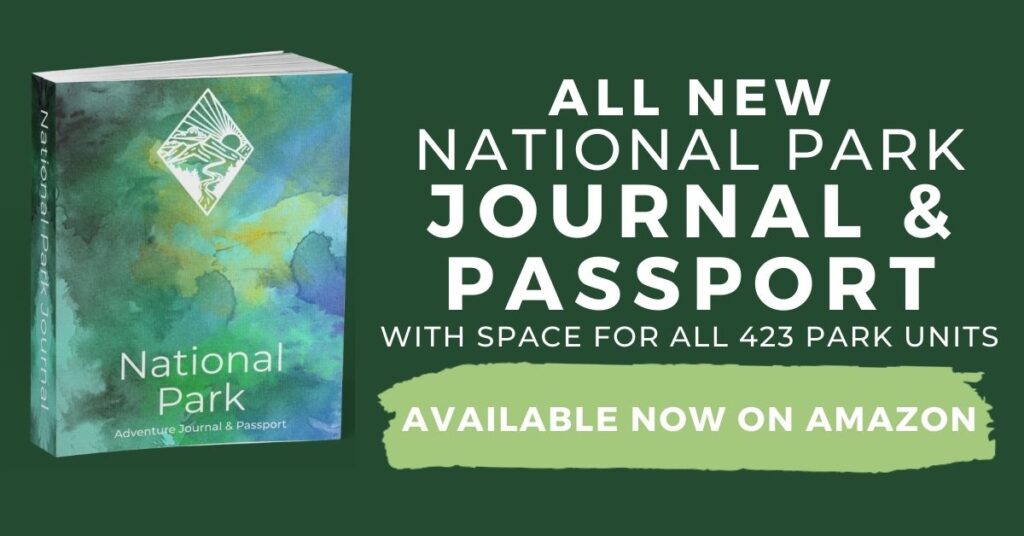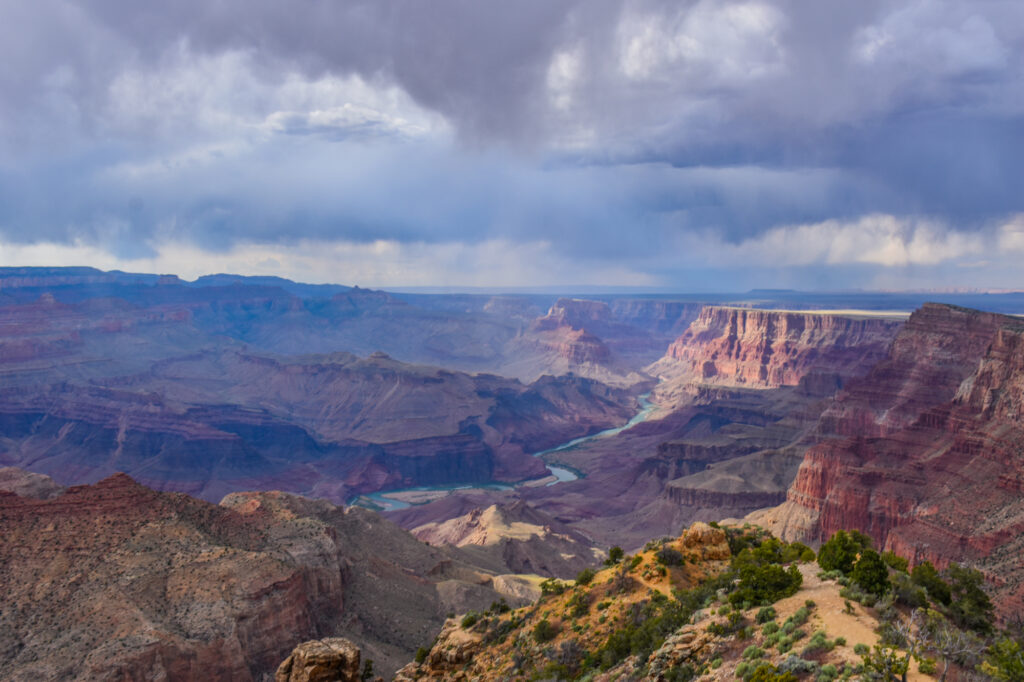
17 Things You Can’t Miss on Your First Visit to Grand Canyon National Park
- Robert Fayette
- Last Modified September 3, 2022
- First Published on April 24, 2020
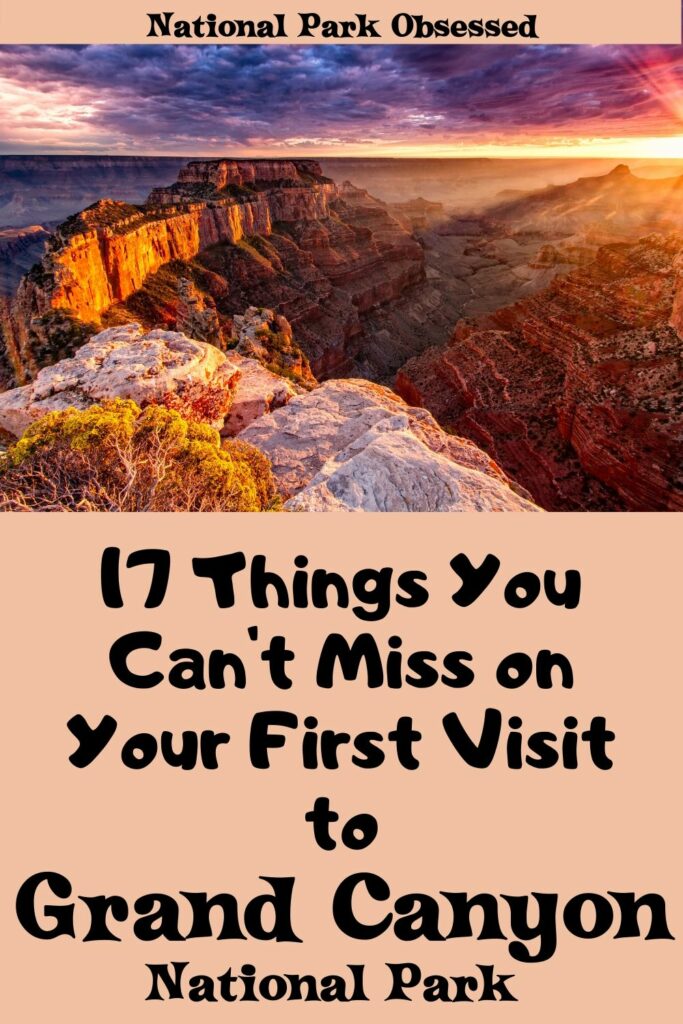
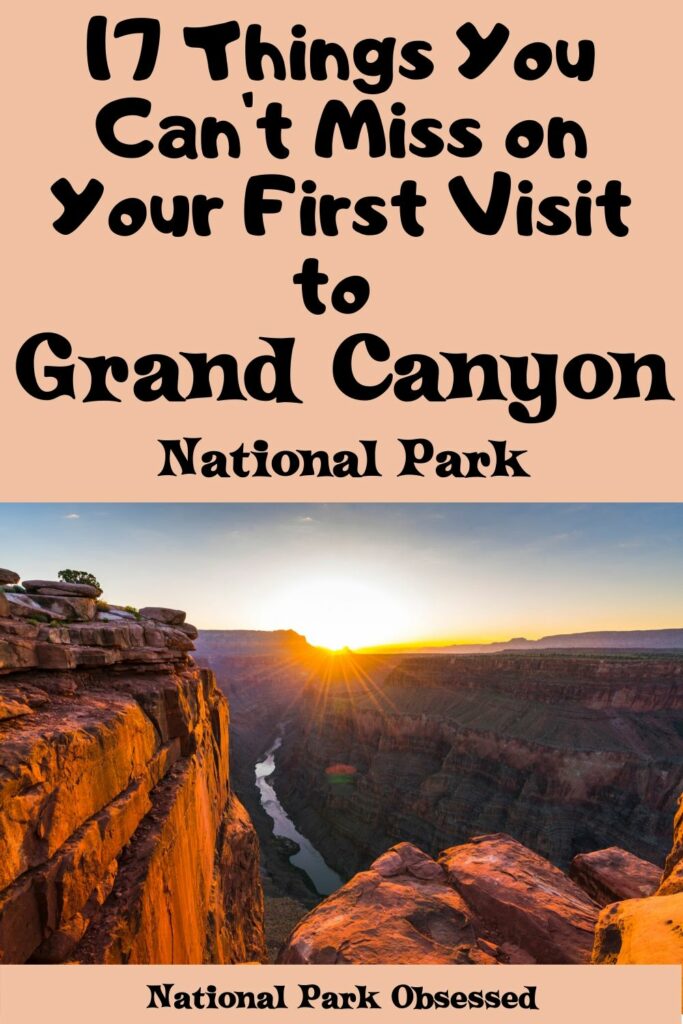
Planning a trip to the Grand Canyon National Park for the first time can be a daunting task. Are you deciding what time of the year and the best way to experience the park from the Northern and Southern Rims? Grand Canyon National Park, located in Northern Arizona is considered one of the Worlds of the World, with over five million visits each year. One of the most visited and photographed National Parks in the world, the Grand Canyon provides no shortage of activities for everyone to enjoy. Here are our 17 things you can’t miss on your first visit to Grand Canyon National Park.
Best of Grand Canyon National Park in a Nutshell
CAN’T MISS: Things You Can’t Miss in the Grand Canyon
HIKES: Best Grand Canyon Hikes
ONE DAY: One Day in the South Rim
CAMPING: Camping in Grand Canyon National Park
NEARBY PARKS: Bryce Canyon, Petrified Forest, Zion

This post may contain affiliate links, meaning if you book or buy something through one of these links, I may earn a small commission at no extra cost to you! Read the full disclosure policy here

Things to Know before you go to Grand Canyon National Park
- Grand Canyon National Park is open year-round.
- The South Rim is open year-round.
- The North Rim is open from May 15 through October 15.
- Grand Canyon West is NOT part of Grand Canyon National Park. It is owned and operated by Hualapai Tribe.
- There are 3 entrances to the Grand Canyon National Park. Two on the South Rim and one of the North Rim.
- There is a significant drive between each the North and South Rim and Grand Canyon West.
| Entrance Station | South Entrance (Tusayan) | East Entrance (Desert View) | North Entrance | Grand Canyon West |
| South Entrance (Tusayan) | 29 miles (44 mins) | 287 miles (5.25 hours) | 234 miles (3.75 hours) | |
| East Entrance (Desert View) | 29 miles (44 mins) | 220 miles (5.5 hours) | 260 miles (4.5 hours) | |
| North Entrance | 287 miles (5.25 hours) | 220 miles (5.5 hours) | 379 miles (6.5 hours) | |
| Grand Canyon West | 234 miles (3.75 hours) | 260 miles (4.5 hours) | 379 miles (6.5 hours) |
- There are two main visitor centers – one on the North Rim and one on the South Rim. There are also a couple of museums and studios to explore.
- There are twelve official National Park Passport Stamps to get in at the Grand Canyon.
- From March to September, plan to arrive at the South Rim by 9:00 AM. The South Rim Visitor Center’s parking lots usually fill by mid-morning.
- Between March 1 through November 30, the park operates a free shuttle system consisting of four routes within the south rim. The Village Route (Blue), Kaibab Route (Orange), Hermit Road Route (Orange) and Tusayan Shuttle Route (Purple) provides visitors with a hassle-free way to access the south rim trails, viewpoints and other points of interest. Shuttle buses arrive at scheduled stops every 15 to 30 minutes.
- Be prepared for the weather. Please note that temperatures tend to rise the further below the rim you get.
- The summer, the average temperature can fluctuate between 73 to 110 degrees
- The spring and fall, the average temperature can fluctuate between 46 to 96 degrees.
- The winter temperatures can range between 25 to 50 degrees
- Remember going down is options, coming back up isn’t. Hiking down into the Grand Canyon is easy, coming back is up is the exhausting part. Be sure of your fitness level is up to the hike you select. Timely rescues in the Grand Canyon are not guaranteed and put others’ lives at risk
- There are numerous hiking trails in Grand Canyon National Park and many are interconnected and it is easy to get confused without a map. Here is my favorite Grand Canyon hiking map.
- The Grand Canyon is one of the busiest National Park in the United States. Book your rooms and campsites as soon as you can.
- There are eight lodges in the Grand Canyon and reservations can be made up to 1 year in advance.
- There are four front-country campgrounds in Grand Canyon. Three of the four campgrounds accept reservations. Two for up to six months and one for up to 13 months in advance.
- Fill your gas tank before heading into the park. Gas is limited in the park. There is one gas station in the south rim and one on the north rim.
- Like all National Parks, the Grand Canyon is home to a range of wildlife. You will likely encounter a range of wildlife from elk to mountain lions to squirrels.
- Respect the wildlife and keep a minimum of 25 yards (75 feet) from large wildlife such as elk
- Do NOT feed the wildlife.
Getting to Grand Canyon National Park
The closest airport to Grand Canyon National Park is Flagstaff Pulliam Airport (FLG). This small commercial airport is located about 1.5 hours from the park. The closest major airport is Phoenix Sky Harbor International Airport (PHX), located four hours south of the park entrance. If you are road tripping through several of the nearby California, Nevada, New Mexico, or Utah National Parks, airport options include Las Vegas (LAS), Los Angeles (LAX), Salt Lake City (SLC) or Albuquerque (ABQ).
There are several transportation operators who run daily shuttles from Williams or Flagstaff to the south entrance of the park and from Las Vegas. Another available option is the Grand Canyon Railway, that offers daily trips from Williams to the Grand Canyon National Park Depot located inside of the park.
Estimated Drive time to Grand Canyon National Park from major cities
- Phoenix, Arizona – 3.45 hours
- Las Vegas, Nevada – 4.25 hours
- Albuquerque, New Mexico – 6 hours
- Los Angeles, California – 7.25 hours
- Salt Lake City, Utah – 9.25 hours
Estimated Drive time to Grand Canyon National Park from nearby National Parks
- Petrified Forest National Park – 3 hours
- Zion National Park – 4.5 hours
- Arches National Park – 5 hours
- Saguaro National Park – 5 hours
- Great Basin National Park – 5 hours
- Mesa Verde National Park – 5.5 hours
- Joshua Tree National Park – 5.5 hours
- Bryce Canyon National Park – 5 hours
- Canyonlands National Park – 6 hours
- Capitol Reef National Park – 6.5 hours
- Black Canyon of the Gunnison National Park – 7 hours
- Great Sand Dunes National Park & Preserve – 8.5 hours
Best Guided Day Tours in Grand Canyon National Park
If you want to make your trip to Grand Canyon as easy and simple as possible, check out these amazing Grand Canyon Day Trips:
Where to Stay in Grand Canyon National Park?
The Grand Canyon Canyon is one of the busiest National Parks and lodging and camping is at a premium. Make your reservations AS FAR IN ADVANCE as possible.
If you can’t find any lodging in the park or would like to stay way from the rim hotel, here are some amazing airbnbs near the Grand Canyon.
Lodging in Grand Canyon National Park
Grand Canyon South Rim Lodging
There are six hotel and three campgrounds on the South Rim of the Grand Canyon. Here are our recommendations for in park lodging:
- El Tovar Hotel – El Tovar is the HISTORIC hotel of the Grand Canyon. This hotel opened in 1905 and retains its elegant European feel that was popular at the time. This hotel is a National Historic Landmark. Due to its historic nature, the rooms are on the small side and each room is unique.
- Check out the prices and availability.
- Read the Tripadvisor Reviews.
- Kachina Lodge – Kachina Lodge is one of the newer lodges in the Grand Canyon and has a more modern feel without detracting from the Grand Canyon. The rooms are more modern sized and come with traditional amenities.
- Check out the prices and availability.
- Read the Tripadvisor Reviews.
Grand Canyon North Rim Lodging
There are one hotel and one campground on the North Rim of the Grand Canyon. Here are our recommendations for in park lodging:
- Grand Canyon Lodge – Grand Canyon Lodge on the North Rim offers comfortable guest rooms and cabins. This historic lodge features native stone and limber along with canyon views.
- Check out the prices and availability.
- Read the Tripadvisor Reviews.
Making a reservation at Grand Canyon
Lodges at the Grand Canyon accept reservations up to 13 months in advance. On the 1st of every month, the hotels start accepting reservations for that month the following year.
For example on May 1, 2020, reservations open for May 2021.
If you are planning to visit during a holiday weekend, school break, or during the summer, it is highly recommended to make your reservation a year in advance.
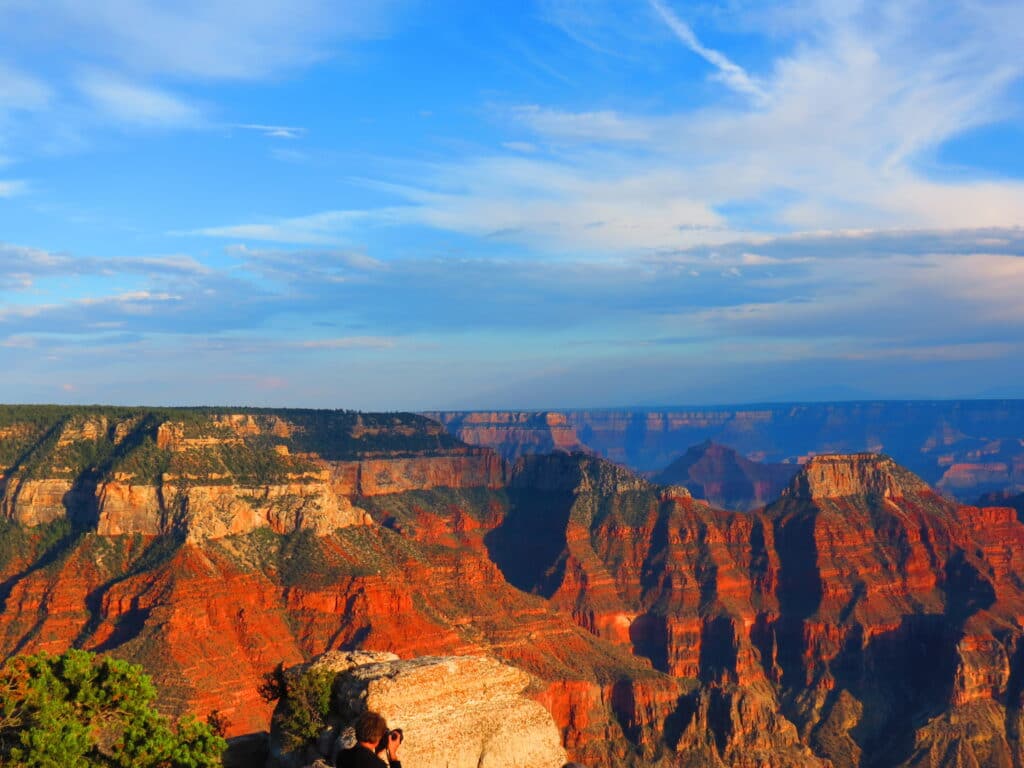
What to pack for a visit to Grand Canyon National Park?
- America the Beautiful National Parks Pass: Grand Canyon National Park costs $30 for a 7-day pass. If you intend to visit more than 3 National Park Services sites in a year, the America the Beautiful Pass will more than pay for itself.
- National Park Passport – The National Park Passport Book is the cheapest and best souvenir of your national park adventures. This book makes it easy to collect the National Park Cancellation Stamps. The cancellation stamps have the date of your visit and make it easy to track when you visited each national park service unit.
- BooRefillable Water Bottles – Do your part to reduce litter in our parks by bringing a refillable water bottle with you. A reusable and refillable water bottle can save you a lot of money and really help the environment. Here are my favorite water bottles
- Hydration Bladder – If you are hiking longer distances, a hydration bladder is the best way to hike with significant quantities of water. It is a rare hike when I don’t bring a full bladder with me.
- Snacks – There are limited services in the park. So pick up all your snacks before you go. Pack a couple of different options so you are prepared for any craving.
- Fruit: Pick hard fruits such as apples or pears. These hold-up in the heat and in packs without getting squished to mush. Another option is freeze-dried fruit. Freeze-dried strawberries are the BOMB. They are crunchy, sweet and the best part is they are lightweight and yummy. These are my new favorite trail snack.
- Vegetables: Cucumbers and carrots hold up well during hiking and in a hot car.
- Granola Bars: Take your favorite non-coated in chocolate granola bars. Anything coated in chocolate will melt and be a sticky mess. My favorite is a selection of Cliff Bars. They are great even when squished.
- Sunscreen – You don’t want to get burned on your visit.
- Lip balm – Your lips need just as much sun protection as your skin does.
- Sunglasses – Similar to sunscreen, you need a good pair of polarized sunglasses to protect your eyes from the glare of the sun.
- Hat – Hats are another sun protection device. A hat can keep the sun off your face and neck and help minimize the need for sunscreen while on the trail.
- First aid kit – As with any outdoor adventure, accidents happen. It is better to be prepared and have a compact first-aid kit ready to help with any accidents.
- Headlamp – Always keep a headlamp handy. You never know when you might want it. It can be used for midnight bathroom runs to sunrise/sunset hikes. A good headlamp makes it easy to operate in the dark.
- Shoes – Shoes are probably the most important piece of gear to any hiker. Hiking shoes should be seen as an investment. On the trail, your feet are your transportation and a solid pair of hiking shoes help support your feet and can prevent injury.
- Hiking Day Pack – A good day pack is the best way to transport all your gear when hiking. I highly recommend getting a backpack that is designed for outdoor use. These packs come with handy pockets and straps. My 40 L day pack has a pocket for my water bladder and a clip to hold the water line in place.
- National Park Obsessed Shirt – Share your love of the National Parks and support National Park Obsessed with a National Park Obsessed T-Shirt.
If you are new to visiting a the National Parks, check out our National Park Essentials Guide to get your started.
17 Things to do in Grand Canyon National Park
10 Things not to miss on South Rim of the Grand Canyon
Mather Point
Mather Point is an overlook adjacent to the visitor center and its parking lot. The Mather Point overlook provides visitors with panoramic views of the canyon for as the eyes can see. The Coconino Sandstone and Kaibab Limestone rock layers usher in stunning views one-mile below into the canyon, while the North Rim of the canyon appears in the distance. The overlook, consisting of two lookout points was named for Stephen Mather, the first director of the National Park Service and one of the first advocates for establishing the Grand Canyon National Park.

Trail of Time
The Yavapai Point and Geology Museum is located between the Grand Canyon Village and Visitor Center. Since it opened in 1928, the geology museum lies directly above Yavapai Point. The history of the Grand Canyon is showcased within the museum through exhibits and large topographical map that provides visitors a better understanding of the geologic history of the area. The museum’s large interior windows provide visitors with sweeping views of the canyon looking north and a glimpse below the rim of the Colorado River and Phantom Ranch through multiple sets of telescopes and binoculars.
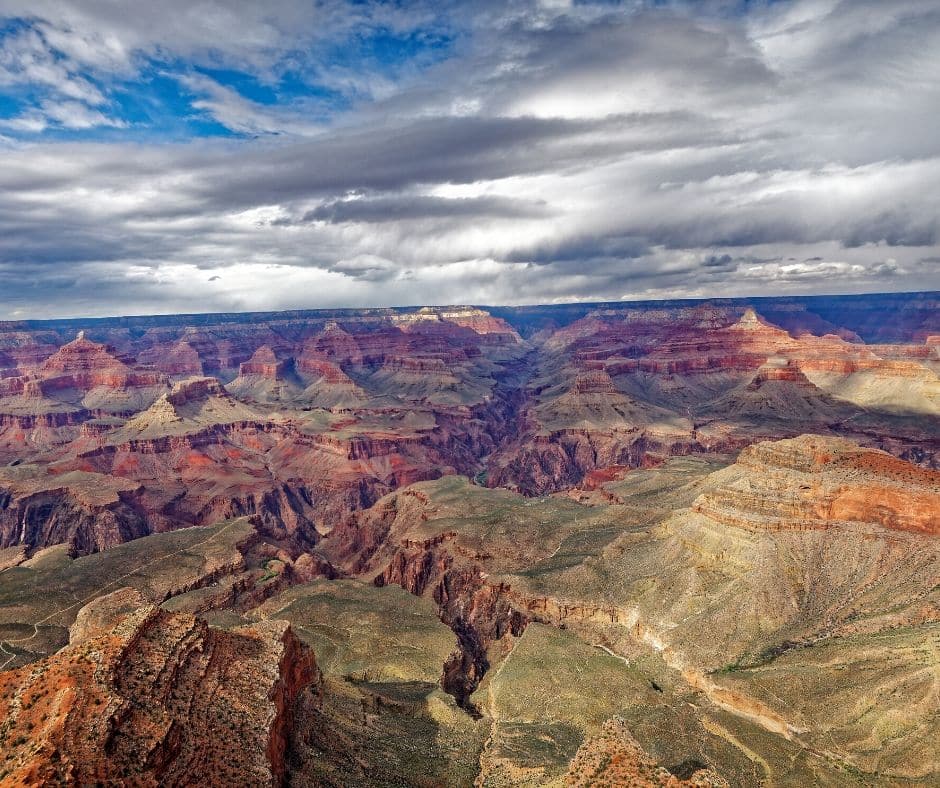
Trail of Time
The Trail of Time begins just west of the Yavapai Geology Museum. The 1.7 mile trail is a portion of the 13-mile Rim Trail that spans between the Yerkamps Visitor Center and Yavapai Geology Museum. Serving as a tribute to the rich geological history of the canyon, the trail is commemorated through brass markers positioned at every meter signifying one million times of time. Visitors are provided the opportunity to learn and understand the geologic periods of the canyon through the colors that line its wall.
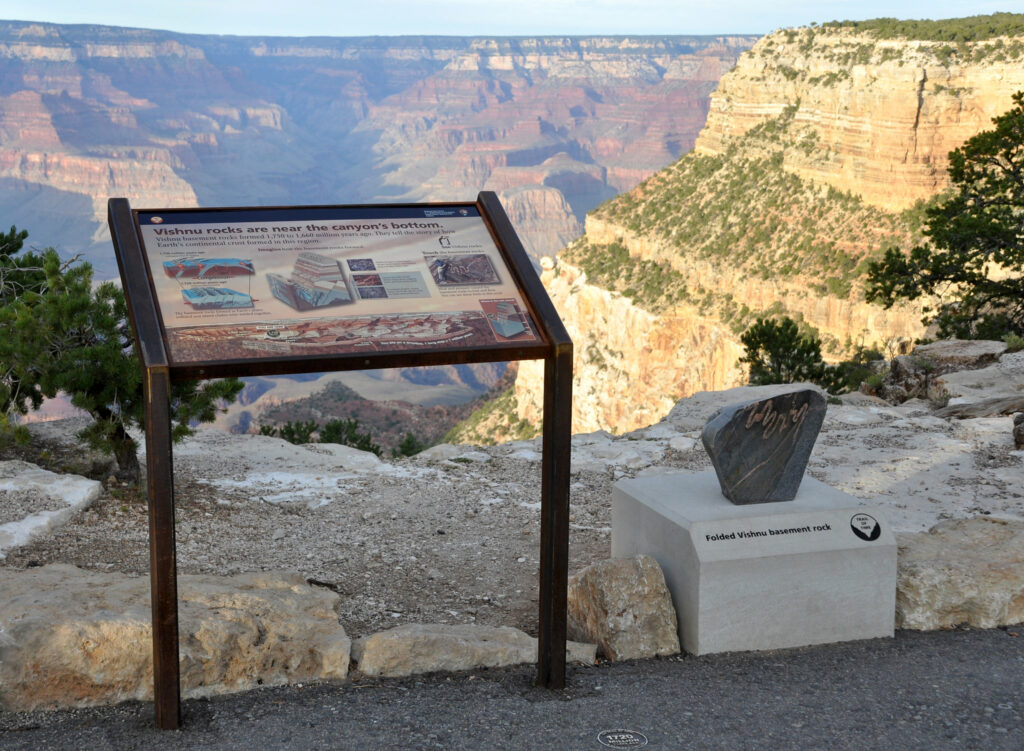
Kolb Studio and Hopi House
Kolb Studio is a park icon located on the Rim Trail near the Bright Angel Trailhead. It was originally operated as a photography stuido and family home by brothers Ellsworth and Emery Kolb from 1904 until 1976. Operated by the Grand Canyon Association, Kolb Studio has evolved through near destruction and refurbishment efforts into a reimagined art gallery and bookstore. Proceeds from the bookstore go to the long-term support of the building.
Mary Coulter’s Hopi House combines architecture with human history designed to resemble a 10,000 year old pueblo dwellings of the Hopi people. Adjacent to the El Tovar hotel, the Hope House was the first introduction for many of the park’s visitors to the lifestyle of its native people from Arizona, New Mexico, Colorado and Utah. An on-site museum contains historic artifacts and demonstrations for visitors to thoroughly enjoy.
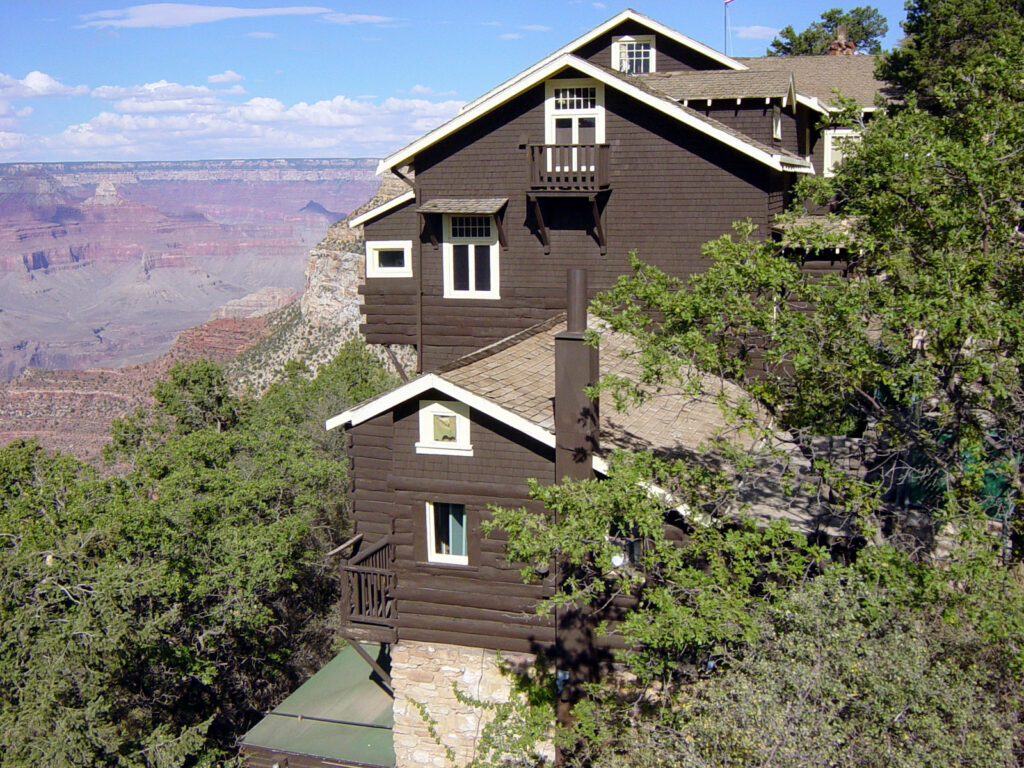
Bright Angel Trail
The Bright Angel Trail begins at the Grand Canyon Village. The 8.0 mile trail descends 4,800 feet from the southern rim to the Colorado River. The most popular hiking trail among park visitors, the trail offers stunning views of the magnificent colors which make-up the inner layers of the canyon. The trail connects hikers with the Tonto Trail, The Plateau Point Trail and River Trail along the way and mule riders making their way to Phantom Ranch. Multiple resthouses are located on the trail prior to reaching the Colorado River.

Grandview Point
Grandview Point is the southernmost lookout point in the south rim. Located halfway between Grand Canyon Village and Desert View, the one-mile trail is very steep and considered a bit dangerous at 7,400 feet. The first established tourist location within the park in 1859, it provides some of the best views of the canyon.
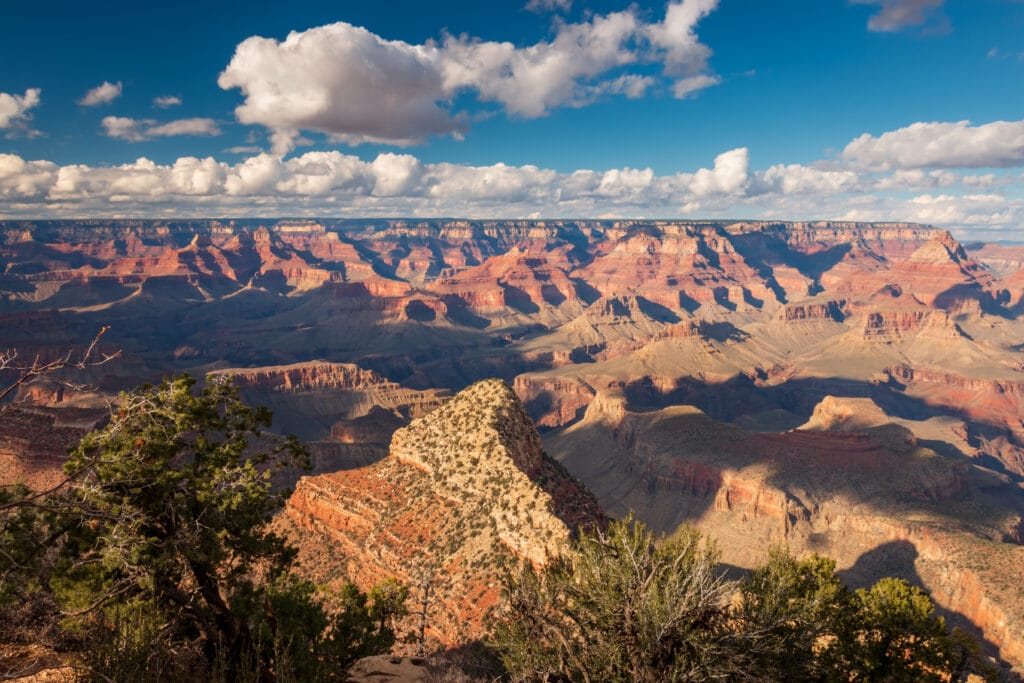
Moran Point
Moran Point is an impressive overlook in the park, popular among artists and photographers inspired to document the landscape and colors of the canyon. It is located at the end of a small road just north of Desert View Drive, 17-miles east of Grand Canyon Village and 7-miles west of Desert View. Colors of sedimentary rock and the Hakatai Rapids are visible below. This is a popular location that tourists enjoy early in the morning and prior to sunset as the light creates moving images reflecting off the magnificent colors of the canyon wall.
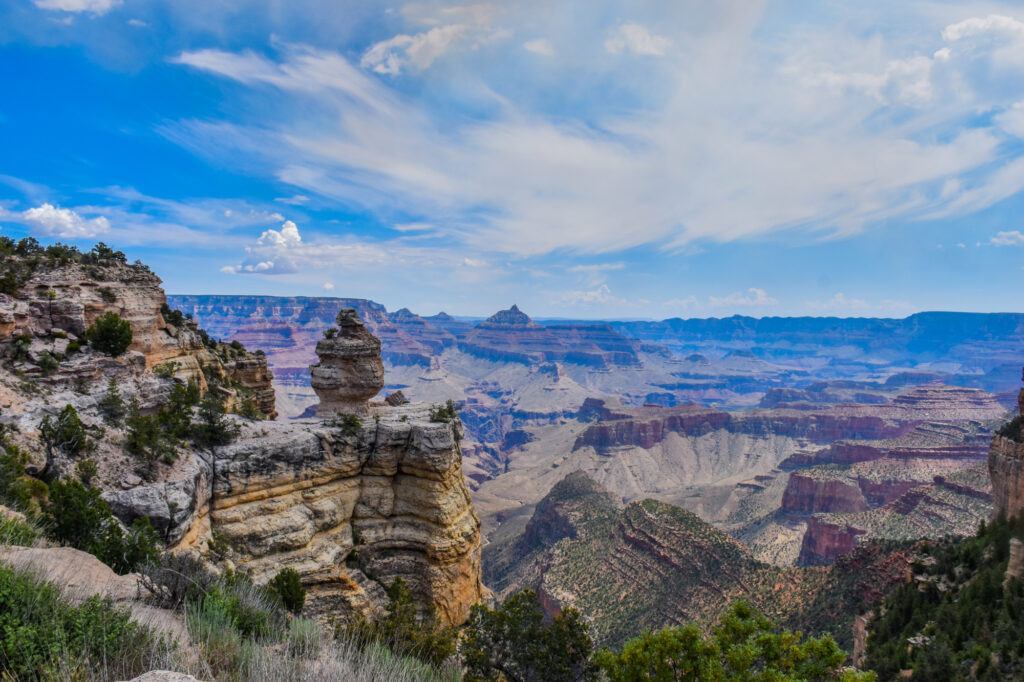
Desert View Watchtower
Desert View Watchtower provides park visitors with their first view of the canyon after entering through the Desert View Entrance gate. The Desert View Watchtower is a 70-foot tall, four story circular-cone structure located near the east entrance of the park. Designed my Mary Coulter to resemble that of an Ancient Indian pueblo ruins, the watchtower promotes the spirit, art and cultural history of the Euro-American and Native Americans who once called the Grand Canyon area their home. Visitors can further acquire knowledge of the Hopi through murals and symbols located throughout the first floor.
A visit to the Desert View Watchtower can’t be complete without a visit to the top. A 360-degree view of the canyon will greet you as you gaze deep into the canyon and Colorado River below from the highest point in the southern rim.
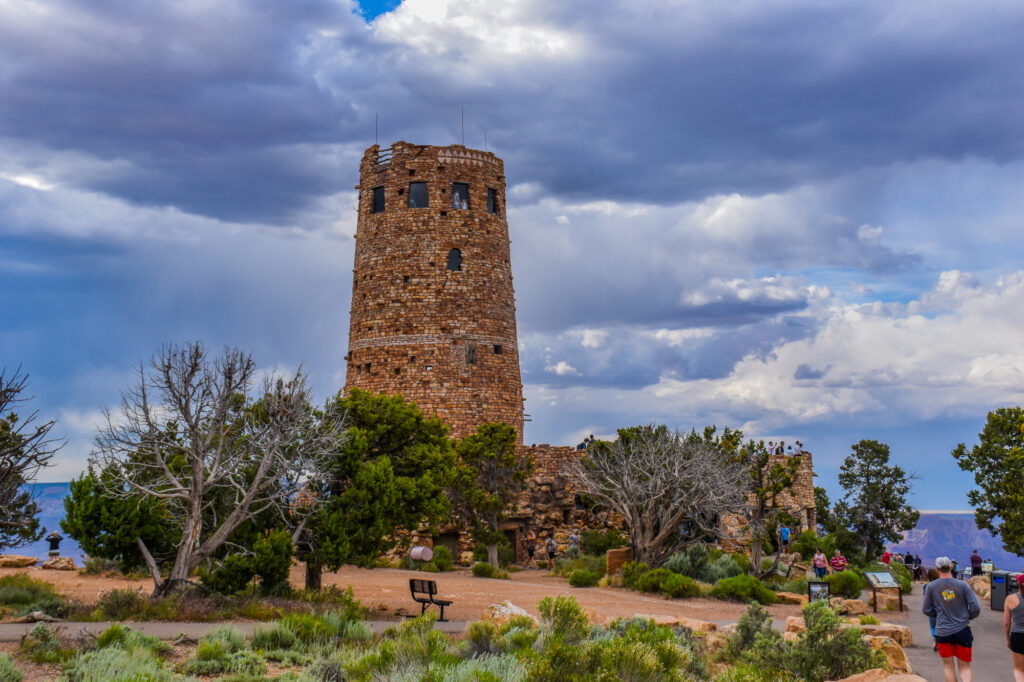
Hermits Rest
Hermits Rest is a historic structure that was built in 1914 by Mary Coulter. It is located at the western edge of the park where the Hermits Rest (Red) Shuttle route ends before returning to Grand Canyon Village. Since its opening in 1914, it has provided shelter and a small snack bar for visitors exploring the western edge of the park. Appearing as a natural stone formation, Hermits Rest combines the spirit of the frontier and solitude, highlighted by an indoor fireplace.
The 9-mile Hermit Travel begins about a 1/4 mile from the shuttle stop at Hermits Rest. The trail offers a challenging opportunity for experienced hikers on that descends over 4,200 feet to the Colorado River.
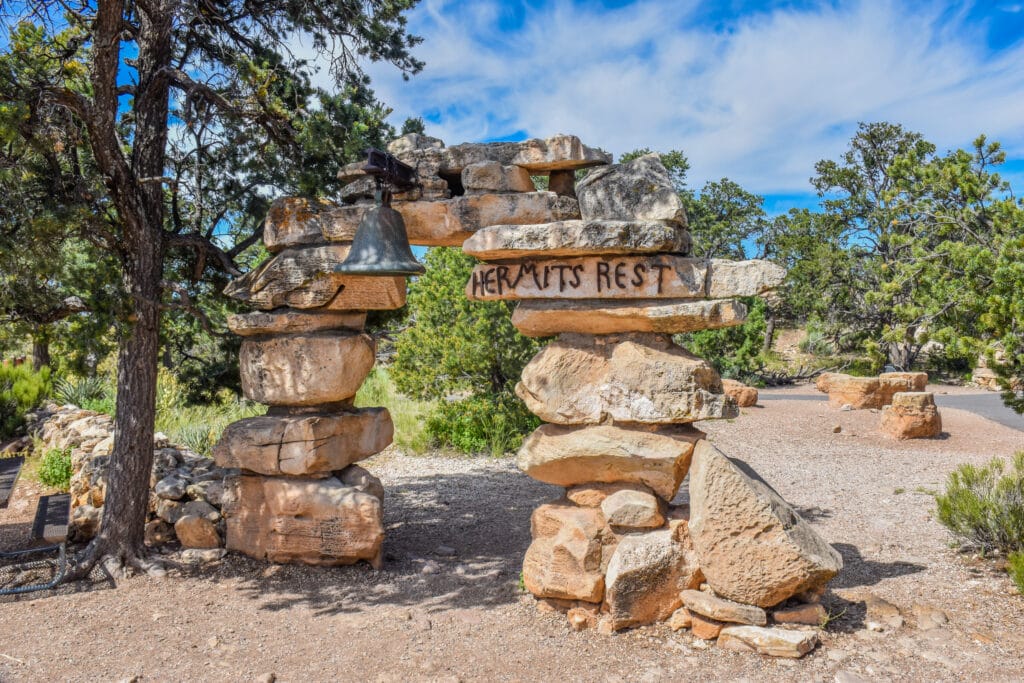
South Kaibab Trail
The South Kaibab Trail is a historical trail within the park. Designed by the National Park Service shortly after they gained control, the trail was constructed between 1924 and 1925 as an easier way to access the inner canyon and Colorado River. The success of the South Kaibab Trail would create the North Kaibab Trail, establishing the first trans-canyon trail in the park.
Originally called the Yaki Trail, it is located 5-miles east of the Grand Canyon Village along Yaki Point Road. Accessible through the Rim Trail or Kaibab Rim (Orange Shuttle) route, the 7-mile trail cuts through the canyon, descending about 5,000 feet within the first 6.5 miles. Hikers are provided with unique perspectives of the inner canyon. Located at mile 1.8, “Ooh Aah Point” is the first point-of-interest where hikers marvel at the eastern canyon through feelings that resonate with the point. Continuing further into the canyon, “Panoramic Point” at mile 5 is highlighted through the sites and sounds of the Colorado River 1,200 feet below.
Those planning to hike the trail should carry with them a suffiicent amount of water and food. Water and restroom access is not available along the trail except for the Bright Angel Campground and Phantom Ranch on the northern side of the Colorado River.
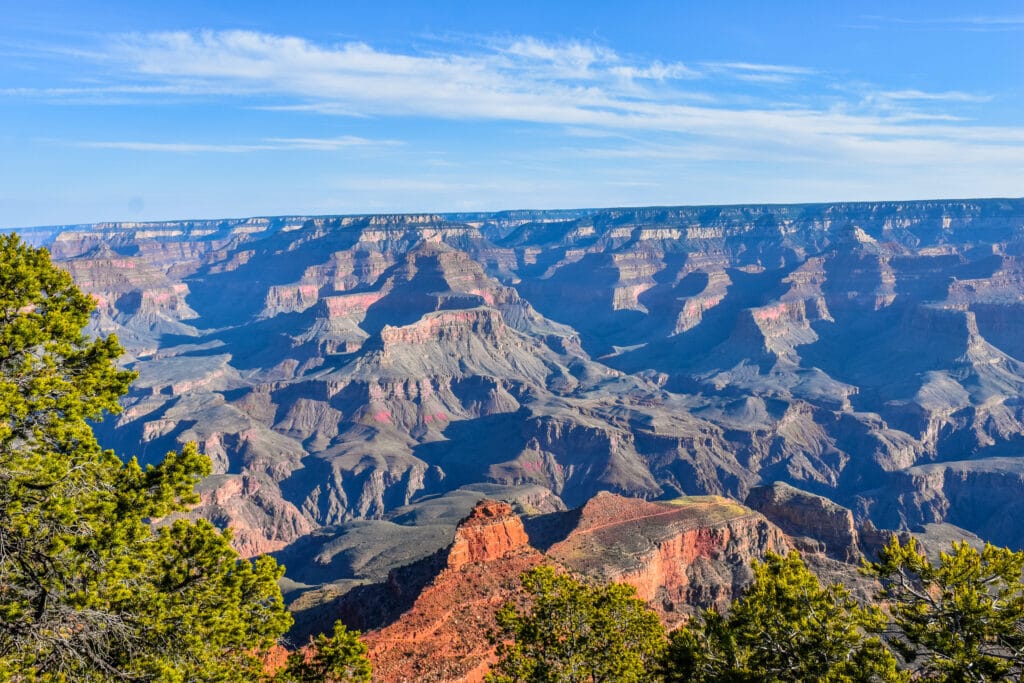
7 Things not to miss on North Rim of the Grand Canyon
Bright Angel Point
Bright Angel Point is located at the end of Bright Angel Point Trail. The short 0.9 mile round-trip trail begins at the southern side of the Grand Canyon Lodge. Open seasonally from May through October, this easy, but popular trail among visitors offers panoramic views of the canyon. Using caution while on the trail is important for hikers because the trail is known for attracting lightning along its exposed portions.
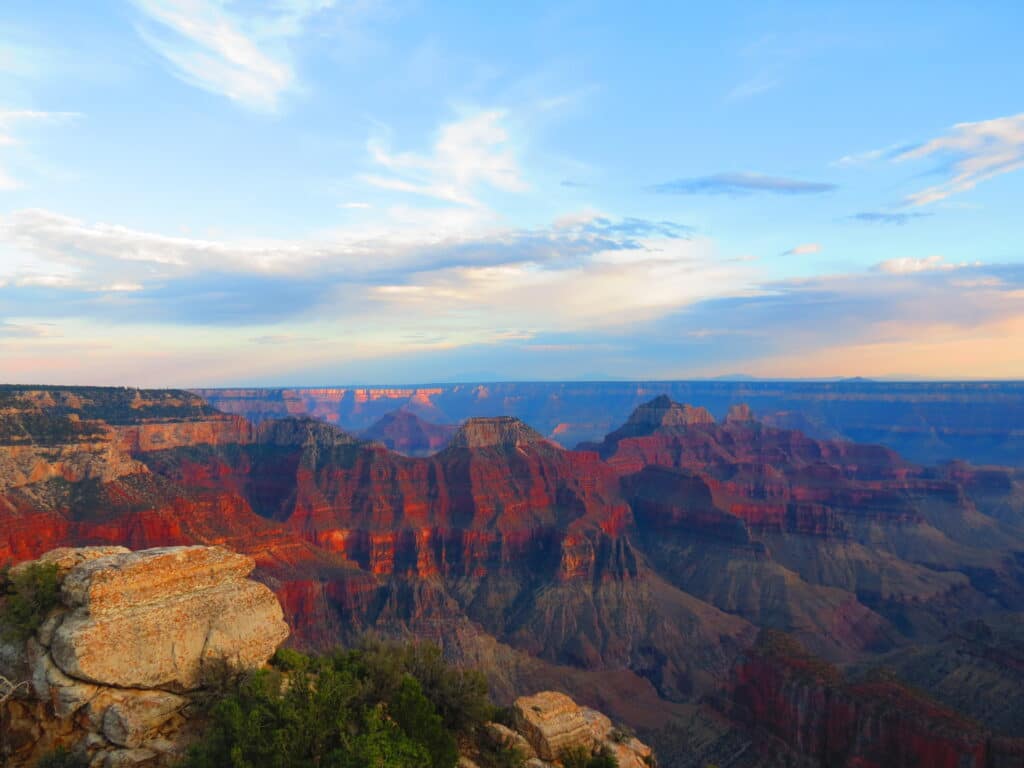
Cape Royal
Cape Royal is the southernmost point along the northern rim, 15-miles from the Bright Angel Point Visitors Center. A 1-mile round-trip trail, it is located at the end of the Cape Royal Trail adjacent to the parking lot. The trail is flat and paved, with interpretive signs along the way. Visitors can enjoy a 260-degree view of the canyon as Wotans Throne, Freya Castle and Unkar Creek are visible. Situated just below the trail to Cape Royal is Angels Window, a natural arch cut from Kaibab limestone.
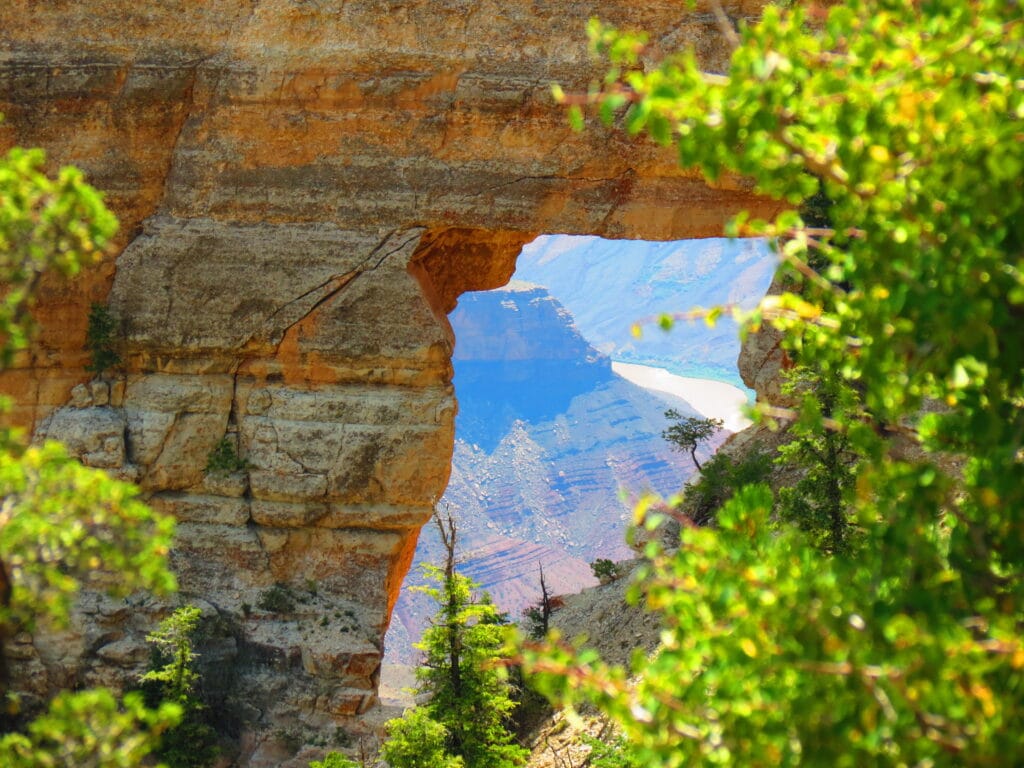
Walhalla Glades Pueblo
The Walhalla Glades Pueblo is a set of six rooms that were common examples of structures located within the ruins of a historic pueblo. The Walhalla Plateau contained over 100 structures scattered along the area over 900 years ago. Visitors can explore the set of six rooms, each uniquely different in size and presentation from each other. Farming and agriculture were common in this summer home for the people for nearly 100-years. The pueblo ruins is accessible through the Cape Royal Road several miles north of its namesake.
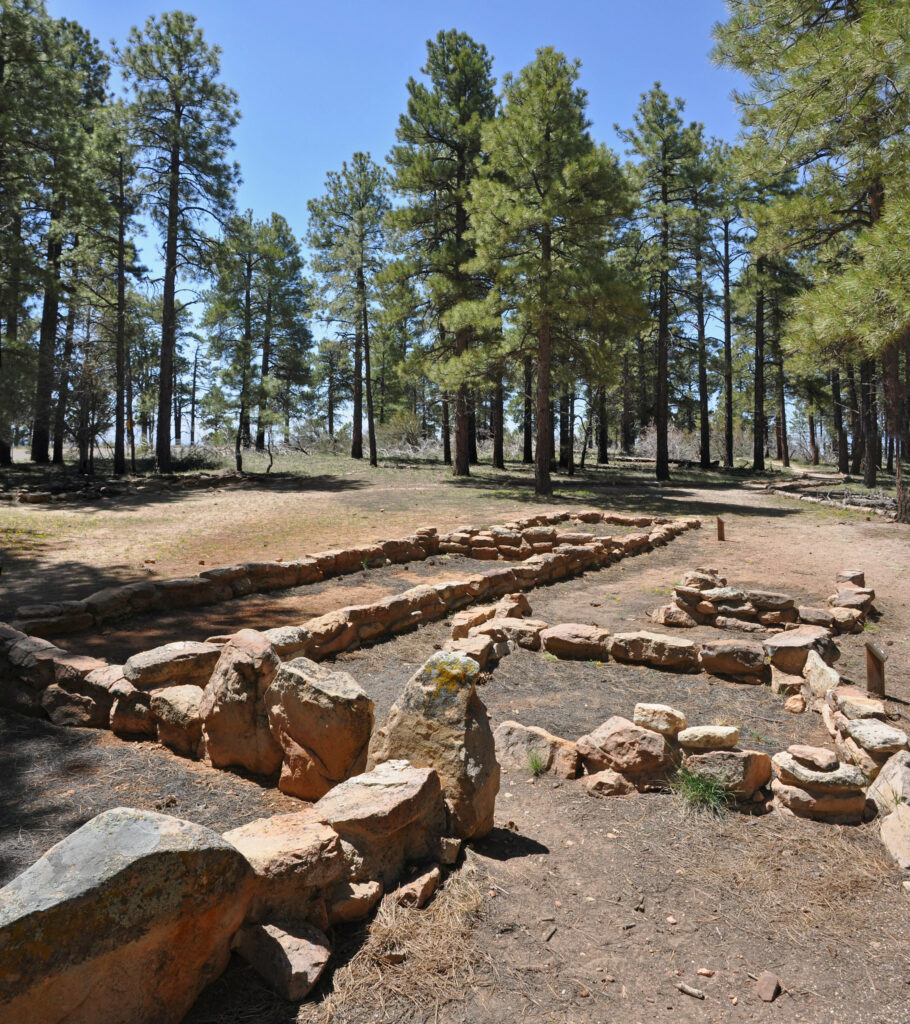
Point Imperial
Point Imperial is the highest viewpoint located in the northern rim. At 8,803 feet, the viewpoint is located 11-miles northeast of Bright Angel Point. The Vermilion Cliffs, Marble Canyon, and Painted Desert are visible in the distance. Early visitors to the north rim would frequent the viewpoint as a location where tour operator led wagon trips originated from. The point connects with the 4-mile round-trip trail towards the park’s northern boundary.

Point Sublime
Considered the “hidden jewel” of the Grand Canyon, Point Sublime is located in a remote area of the park. At the end of a rugged 18-mile dirt road through the Kaibab National Forest, the point introduces a unique perspective of the northern rim, not experienced at any other viewpoint in the park. A two-hour drive may seem a daunting task to many, but to those who have visited Point Sublime, they will tell you that the panoramic views of the canyon and Boucher Rapids were wroth it.
Backcountry camping permits are available and must be obtained though the Backcountry Information Center. Camping in designated campsites is limited to two-nights in length and must be reserved well in advance through the park website.
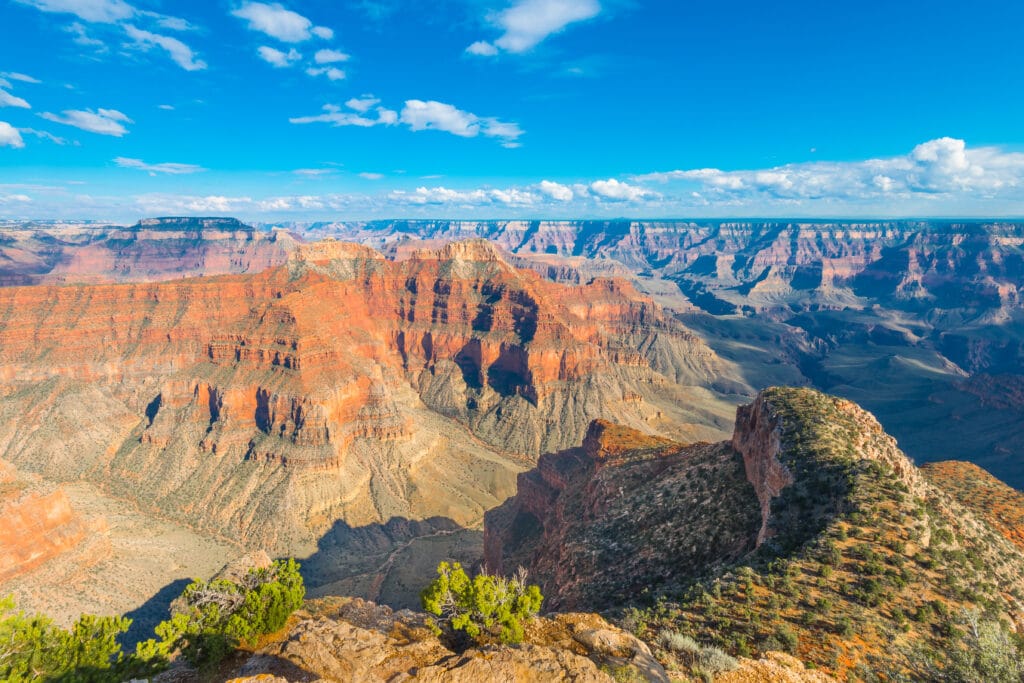
North Kaibab Trail
Coconino Overlook
The Coconino Overlook is a 1.3 mile rountrip trail located along the North Kaibab Trail. Named for the Coconino Sandstone, the overlook contains and elevation change of 800 feet until reaching the overlook. The trailhead for the North Kaibab Trail is located along the road to the North Rim Visitor Center. Those continuing along the trail will reach the Supai Tunnel four-miles later.
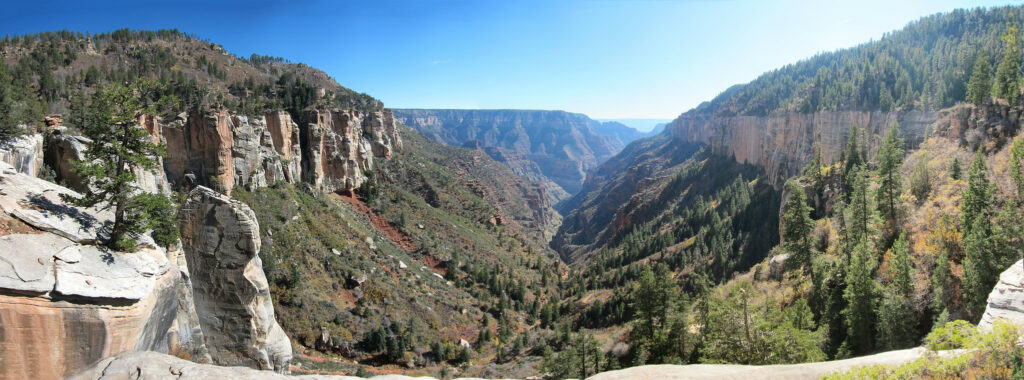
Roaring Springs
Roaring Springs is the area of the park responsible for providing drinking water for every visitor of the park through a pipeline buried underneath the trail, fed directly to the southern rim. Located 4.7 miles down the North Kaibab Trail, Roaring Springs is supported by the Kaibab Plateau and Kaibab National Forest. Upon reaching the springs, hikers can utilize the park’s free water bottle filling stations before exploring naturally-fed springs, as deep as 30-feet before ascending back up the trail.
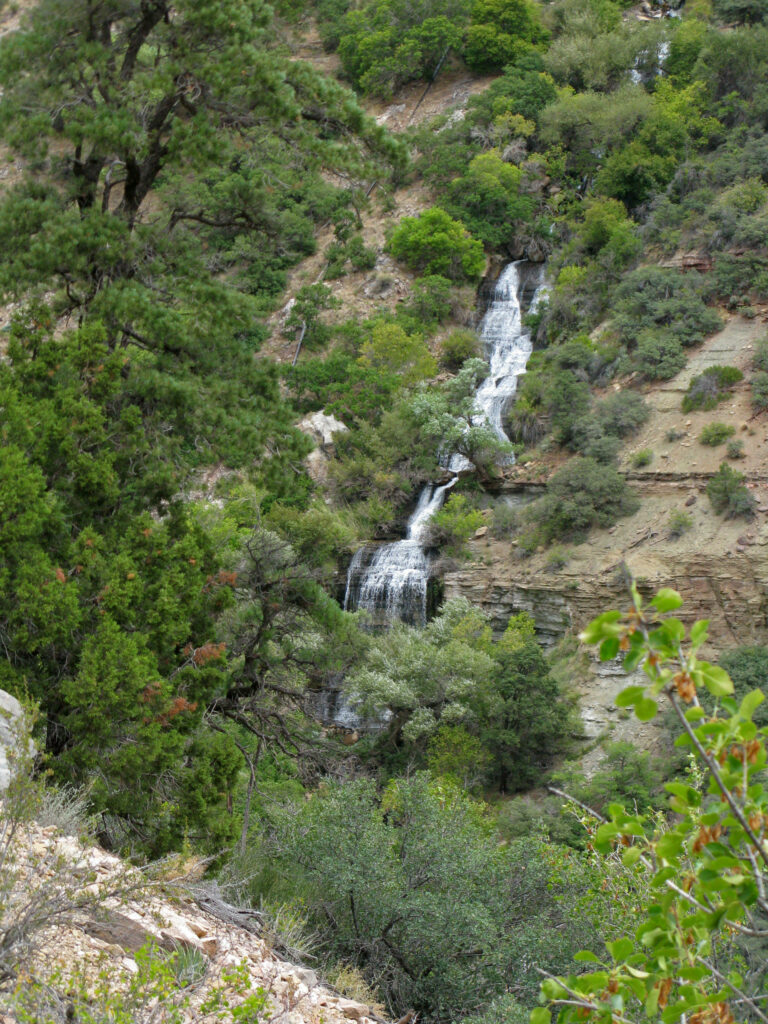

17 Things you Can’t miss on your First Visit to Grand Canyon Summary
Here is our list of 17 things to do on your first visit to Grand Canyon. These are some of our favorite activities in the park and are sure to make your first visit to the Grand Canyon memorable. Let us know if there is anything you would have added to your first visit to Grand Canyon.
Get help planning Grand Canyon National Park Trip:

Robert Fayette
Hi, I'm Jennifer!

Welcome to the wonderful world of National Parks. I'm here to help you plan your NEXT amazing adventure through the United States National Parks and beyond. I want the national parks to be accessible to all.
I live in Tennessee, and when I'm home, you can find me hiking in the Smokies and the Cumberland Plateau.
58/63 National Parks
250+/423 National Park Units
Want to know more? Start Here.
ACKNOWLEDGEMENT OF LAND
On this site, we promote travel to the United States and beyond that are the traditional lands of Indigenous and First Nations peoples.
With respect, I make a formal land acknowledgment, extending my appreciation and respect to these lands’ past and present people.
To learn more about the people who call these lands home, I invite you to explore Native Land.
DISCLAIMER
National Park Obsessed assumes no responsibility or liability for any errors or omissions in the content of this site (NationalParkObsessed.com). The information contained in this site is provided with no guarantees of completeness, accuracy, usefulness or timeliness. You are encouraged to conduct your own due diligence before acting on the information provided on this site and should not rely on the opinions expressed here.
There is an inherent risk in all outdoor recreation activities, the reader assumes all responsibility for their own personal safety.
DISCLOSURE
We are a participant in the Amazon Services LLC Associates Program, an affiliate program designed to provide a means for us to earn fees by linking to Amazon.com and affiliated sites.
Privacy Policy • About Us • Contact
Select stock photography provided depositphotos
Copyright ©2023 National Park Obsessed, LLC
Last Updated on 3 Sep 2022 by Jennifer Melroy

